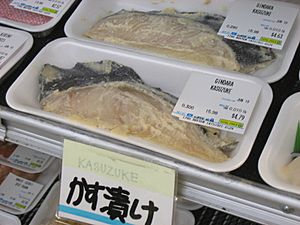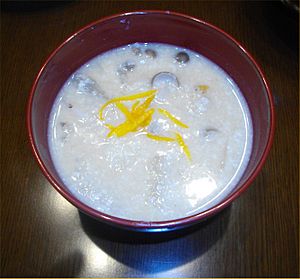Sake kasu facts for kids
Sake kasu (酒粕) or sake lees is a white, paste-like cooking ingredient. It tastes fruity, a bit like Japanese sake. Sake kasu is what's left over after sake is made. It's a by-product of sake production, meaning it's something extra that comes from making sake. It still has about 8% alcohol, is very healthy, and offers many benefits.
Sake kasu is often used as a marinade for fish, vegetables, and meat in Japanese dishes. It helps to make the food taste even better, adding a rich, savory flavor called umami. You can also find sake kasu in beauty products like cosmetics and skincare items. In Japan, using sake kasu is part of the "no waste" culture, where nothing is thrown away if it can be used in other ways.
There's also something similar called mirin kasu, which comes from making Mirin, a sweet Japanese sake. Like sake kasu, mirin kasu can also be used as a healthy food ingredient.
Contents
How Sake Kasu is Made
Sake kasu is created during the process of brewing sake. First, a special kind of fungus called koji is added to steamed rice. This koji fungus releases an enzyme that breaks down the rice starch into sugar.
Next, yeast is added to this mixture. The yeast then turns the sugar into alcohol. After this, the fermented rice mash is pressed. The liquid sake is squeezed out, and the solid leftover part is called sake kasu. One sake brewer, Todd Bellomy, shared that for every 700 liters of sake they make, they also get about 250 liters of sake kasu.
The weather when the rice grows can affect how much sake kasu is made. If it's very hot, the starch in the rice is harder to dissolve. This means more sake kasu is produced, and the sake itself might not taste as strong. But if the weather is cooler, the rice grains are finer and dissolve more easily. This results in less sake kasu and a stronger-tasting sake.
What's Inside Sake Kasu
Sake kasu is very nutritious! It's packed with good things like protein, carbohydrates, fat, vitamins (including some B vitamins), fiber, and amino acids.
Studies have shown that sake kasu might help reduce the risk of a liver condition called non-alcoholic fatty liver disease (NAFLD). A Japanese TV show, "Tameshite Gatten," explained that the fiber and special proteins in sake kasu can help lower "bad" cholesterol levels.
It doesn't matter much if sake kasu is dried with heat or by freezing; its nutritional value stays mostly the same. Some studies suggest that eating sake kasu might help older people keep their brain and muscle functions healthy.
There's also "fermented sake kasu," which is made by adding good bacteria to sake kasu during fermentation. Eating this type of sake kasu might help reduce symptoms of allergies, like hay fever and skin conditions such as eczema. It's believed to help reduce swelling and irritation.
Foods Made with Sake Kasu
Sake kasu is a popular ingredient in Japanese cooking. It has a unique taste and contains yeast and enzymes that work well with other foods. When you marinate food in sake kasu, it can boost the umami flavor, making the dish taste richer and more savory.
Kasuzuke
Kasuzuke is a Japanese way of pickling or marinating food using sake kasu. You can use it for different ingredients like cucumber, daikon (a type of radish), salmon, or chicken. To make it, you mix sake kasu with miso, mirin or sake, sugar, and salt. You can change the amounts to your liking. Then, you add the food you want to marinate and let it soak up the flavors. Kasuzuke can be eaten raw or cooked, depending on the ingredient.
Kasujiru
Kasujiru is a warm soup often eaten in Japan during winter. It's made with sake kasu, different vegetables like Japanese daikon, carrots, and burdock, along with miso, salted salmon, and dashi (a Japanese soup stock).
Other Foods with Sake Kasu
You can buy sake kasu in packages at grocery stores in Japan. Many Japanese home cooks use it to make delicious things like bread, cakes, and even ice cream.
There's also a snack called Kasu senbei, which is made by toasting a flattened piece of sake kasu on a grill. Another food is narazuke, which is a type of winter melon that's heavily salted and marinated in sake kasu. It's a famous local product from Nara Prefecture.
Amazake is a traditional Japanese drink that is sweet and creamy. There are two versions: one with alcohol and one without. The alcoholic version uses sake kasu as a main ingredient. The non-alcoholic version uses rice and rice koji. The rice koji version of amazake is often considered more nutritious, sometimes even called "IV drip to drink" because it's so full of good things like glucose, B vitamins, and fiber.
Other Uses for Sake Kasu
Sake kasu is also used in many cosmetics and skincare products, like facial masks, bath powders, and face creams. There's an old story about an elderly man who worked in a sake brewery. His hands looked young and smooth, even though his face was wrinkled. This made cosmetic companies interested in using sake kasu in their products.
Scientists found that the yeast from sake fermentation might be the reason for the youthful-looking hands. This led to a famous skincare product line called Pitera. Sake kasu can also be used to make homemade beauty products. If you mix sake kasu with things like citrus juice, honey, rice water, aloe vera, or rose water, you can make a mask for your face and body. It can help make skin brighter and the antioxidants in it can help produce collagen, which keeps skin firm. Because sake kasu has alcohol, it's a good idea to use sunscreen after using a homemade sake kasu mask.
Sake kasu can be good for skincare because it contains special fats that can help skin look more moisturized and softer. People have said it can help reduce redness from acne, fade age spots, and tighten pores.
The "No Waste" Culture
Sake kasu is a great example of Japan's "no waste" culture. Even though it's a leftover from making sake, the Japanese found many ways to use it instead of throwing it away. A lot of sake kasu is produced, and it used to be considered industrial waste. But now, to reduce waste, it's recycled into other products. Some sake breweries sell their sake kasu directly to restaurants or package it to sell in stores.
Mirin Kasu
Mirin kasu is another by-product, created when mirin (a sweet Japanese sake) is separated from its brewing mixture. Mirin is a sweet, syrupy sake with about 14% alcohol, used for seasoning, marinating, and glazing food. Mirin kasu is mildly sweet, not as strong as sake kasu.
People have used mirin kasu since the Edo Period in Japan as a "sweet treat." Like sake kasu, mirin kasu can be used in cooking. It's great as a marinade for pickled vegetables, fish, and meat. It can also be used in baking and drinks.
Mirin Kasu Nutrition
Mirin kasu contains water, alcohol, fat, carbohydrates, and protein. It has a special type of protein called resistant protein. This protein is good for your health because it can help improve your body's defenses against certain health issues and improve digestion.
See also
 In Spanish: Sake kasu para niños
In Spanish: Sake kasu para niños




